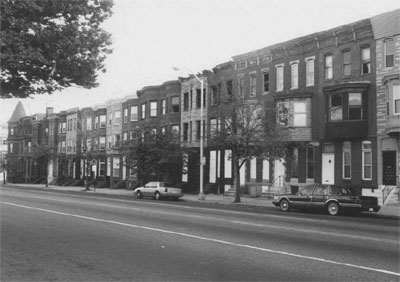Works in Baltimore |
|
|---|---|
 Photo credit: Mary Ellen Hayward |
|
| Name: | Old East Baltimore Historic District |
| Address: | bounded by the Jones Falls, Greenmount Cemetery, North Avenue, Broadway, and Eager Street |
| Standing? some | Year: mid-1800s |
The Old East Baltimore Historic District is a mainly residential area of Baltimore City that grew up northward from the original mid-18th century settlement east of the Jones Falls, known as Jones Town, or Old Town. The district comprises some 70 city blocks covering approximately 194 acres, generally bounded by the Jones Falls, Greenmount Cemetery, North Avenue, Broadway, and Eager Street. The southern blocks of the district are characterized by vernacular Greek Revival-style working-class housing, constructed in the mid 1840s to mid-1850s for the large numbers of Irish and German immigrants settling there. The neighborhood did not being to grow significantly until after the Civil War when it filled with three-story Italianate rowhouses and smaller, mid-block two-story houses built for these same immigrant groups who by then had established important, architect-designed Catholic churches and charitable institutions in the area. The finest of these houses face two residential squares, Madison Square, laid out in 1853, and Johnson Square, laid out in 1883. By the late 1880s and early 1890s all of the blocks in the historic district had been filled with substantial rowhouses showing the influence of Queen Anne and Renaissance Revival styles, and church construction continued apace. The churches in the district, built between the early 1850s and 1902, show the range of Revival styles popular in the second half of the 19th century and include good examples of Italianate, Gothic, Richardsonian Romanesque, Northern European Romanesque, and French Romanesque. The main commercial corridor in the district, Harford Avenue, has suffered substantial resource losses and has been excluded from the boundaries of the Historic District. The remaining blocks, however, with their many originally ethnically oriented churches and residences, retain a high degree of integrity. The Old East Baltimore Historic District is historically significant for its association with the history of immigration in Baltimore. The area was the primary location, in the latter half of the 19th and the first decades of the 20th centuries, of two of the most prominent immigrant groups in the city, the Irish and the Germans, whose arrival in Baltimore in the 1840s and 1850s exactly corresponds to larger national patterns. Both groups settled initially in Fells Point, where their ships docked, but gradually made their way north to newly developing areas where they built important churches, schools, and institutional buildings. Their two Catholic churches, St. John's and St. James, are already listed on the National Register of Historic Places. The area gains special significance in this context because the majority of the rowhousing in the Historic District was built by local German immigrant builders, often with financing provided by the German churches or German-affiliated building and loan associations. Additionally, several of the most prominent buildings in the district were designed by architects of German birth or descent, most notably John Rudolph Niernsee and George A. Frederick. The district derives additional significance for its architecture, because so much original housing and church architecture remains intact that the ranges of architectural styles used from the 1840s through the early 1900s, particularly as adapted to vernacular residential buildings, but also including church architecture, can be clearly seen. The area also provides an excellent example of the way in which most Baltimore city blocks were developed in the 19th century to offer a range of sizes and prices of housing, so that people of varying economic means could live in the same area. Additionally, the area contains two important examples of a popular mid-19th century planning trend, that is, the creation of park-like residential squares in the midst of the urban fabric, surrounded by housing for the more affluent members of the community. The Old East Baltimore Historic District recognized by the National Register of Historic Places, added 12/27/2006 |
|

